TWO PINTS OF LAGER AND A PACKET OF CRISPS, PLEASE
Pubs weren’t always the high-windowed, dazzlingly lit palaces of pleasure they are nowadays, you know. Before Sky Sports and fake Irish decor, the atmosphere down your friendly local was more often an intimidating mixture of stale cigarettes, mouldering carpet and imminent violence. For most, the first glimpse inside was from a perch atop Daddy’s shoulders, through the shutters of the off-licence at the side of the pub. As his takeaway bottles of black ‘n’ tan were handed over, gloomy figures beyond retreated into Lowry-esque huddles around an open fire, soberly dressed yet slovenly drunk. A scary vision of the future; but a trip worth it for the reward, a small plastic pack containing some crackers, a cheese triangle and a tiny, pickled silverskin onion.
Landlords have always kept a variety of snacks behind the bar. It makes perfect sense. Most booze is high in carbohydrates, which sends a customer’s blood sugar up and kick-starts the pancreas’s secretion of insulin. Too much of this combined with alcohol’s tendency to inhibit the production of anti-diuretic hormones leads to hunger. Bingo! The licensee can now flog a nice packet of salted peanuts (which, by an amazing coincidence, also leaves the punter more thirsty and in need of another beer). That’s all the basic biochemistry they teach at brewer’s school, which is why there is no cure for a hangover other than hair of the dog.
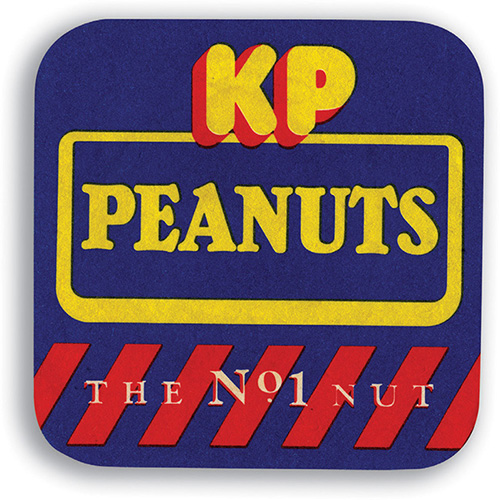
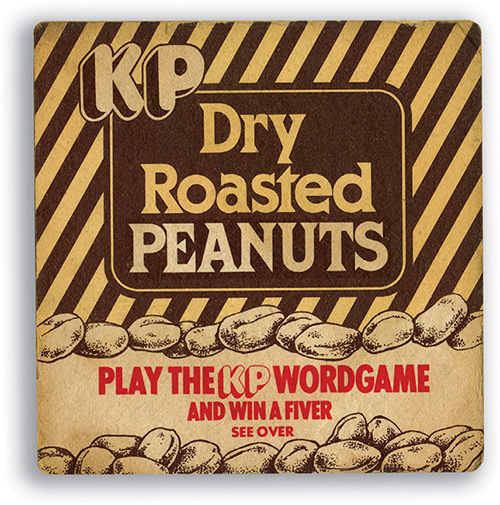
The universally loved KP nuts (1953) and their not-so-universally loved dry roasted cousins (1980).
Sealed bags of nuts were where it was at for a long time. KP (manufacturers Kenyon Produce, the adopted branding for all United Biscuits’ snack products from the mid-’70s onward) were undisputedly number one in the field, something they celebrated with the launch of the immodest ‘No. 1’ range in 1953 and relentless advertising thereafter. New wave singer, and Noel Fielding lookalike, Lene Lovich must have been surprised to see her top ten hit ‘Lucky Number’ seconded to promotional duties and performed by a spiky-haired, KP-fixated wide boy on telly. By the time pretend punk Billy Idol’s ‘Rebel Yell’ spiced up the honey roasted adverts, the message was clear: these were peanuts that recognised no boundaries of class, age, gender or taste.
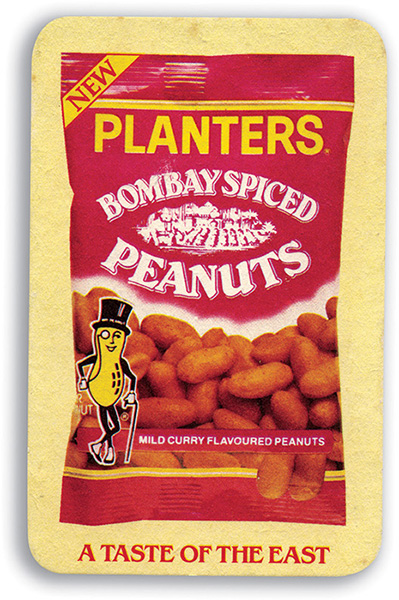
Finger-coating good: Bombay Spiced peanuts circa 1982.
KP’s competitors sought out niche markets. Golden Wonder’s nuts were ‘jungle fresh’ or ‘big and juicy’, according to the lion-wrestling, elephant-taming Tarzan-o-gram in their adverts. Rowntree Sunchasers, clearly the Club Med of legumes, were ‘toasted’ not roasted peanuts, whereas American interlopers Planters were aimed squarely at the toff market, or so the monocle, top hat, white spats and ebony cane ensemble of their Mr Peanut character would seem to indicate. What Planters did bring to the cocktail party, in 1978, was the UK’s first dry roasted peanut, liberating the packet of nuts from under the horse-brasses of the local hostelry and into the stainless-steel serving bowls of swanky downtown wine bars.
Smiths quickly followed suit, as did Golden Wonder with the unsubtly monikered Chasers, though KP were typically vain in claiming their own ‘seductively spicy and very different’ dry roasted peanuts to be ‘the greatest bite since Cleopatra’s Asp’. Sales peaked in 1981, though just three short years later had declined enough for KP to respond with alternative salt ‘n’ vinegar and smoky bacon flavours. The market struggled to sustain such diversity, however, leading professional curmudgeon Michael Parkinson to grumble in his Daily Mirror column about the shortfall of plain peanuts available on a business-class flight to Manchester.
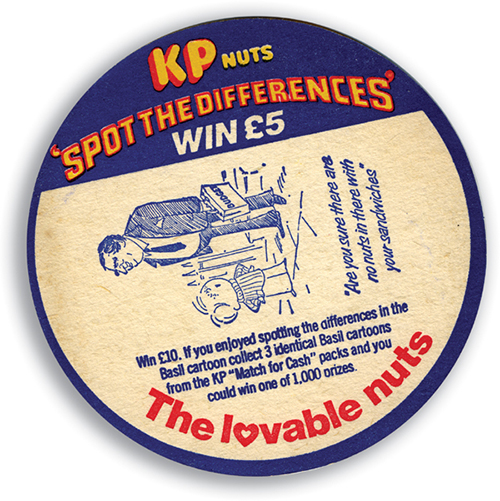
KP make with the topical Denis Healey gags (1978).
Already unpopular with anaphylactics, the savoury bowl-based peanut suddenly didn’t seem so appetising to anyone but the finest connoisseur of other people’s trace urine samples (unless that’s yet another urban myth).
Who were these adults kidding anyway? They’d happily offer an array of juvenile snacks and crisps at their grown-up soirées, leaving the kids to watch from the top of the stairs as guests munched their way through the cheese balls. But, in a blind taste test, would they know the difference between a Tudor Roll and a Smiths Buff? Not on your nelly. In the early ‘70s, no Christmas do could begin without the car keys in a dish on the table and a carton of Twiglets to pass around. The famously knobbly snacks were created in 1929 by a French chef, experimenting with crispbread dough and yeast extract in the Peek Frean company’s Bermondsey kitchens. For years they (and their dairy-heavy counterparts, Cheeselets) were the only genuinely adult-oriented party snack out there. But in 1982, that all changed.
Roger McKechnie and Ray McGhee, a couple of ex-Newcastle university chums, got together to bemoan the state of the snack industry. There was, they reasoned, a gap in the market for ‘aspirational AB’ nibbles.
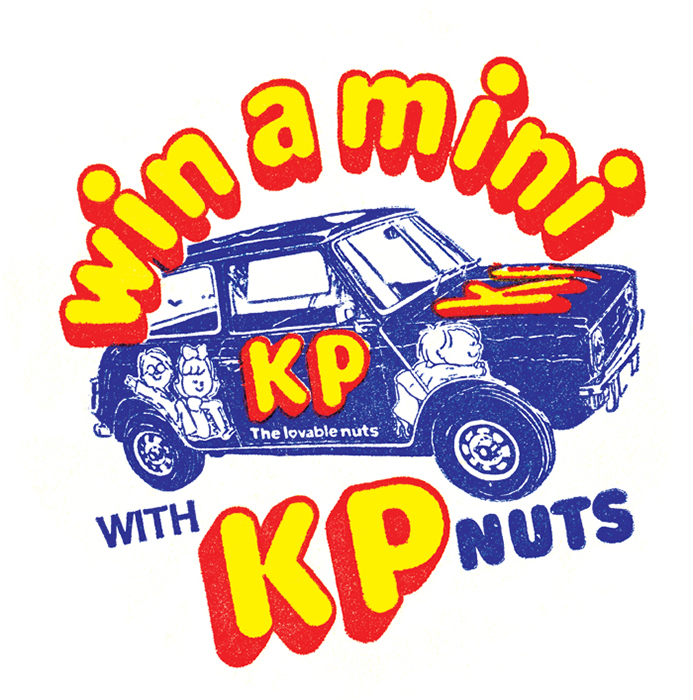
McKechnie, the former general manager at Tudor, had an idea that the more sophisticated barflies and Bellini drinkers could handle an exotic product. McGhee, European vice-president for an ad agency, figured that expensive-looking, oddly designed packaging would attract the attention of first-time buyers. So they formed Derwent Valley Foods to produce an initial range of ‘first class snacks from around the world’, named them after Jules Verne’s eccentric gentleman explorer, Phileas Fogg, and broke nearly every rule in the book in the process.
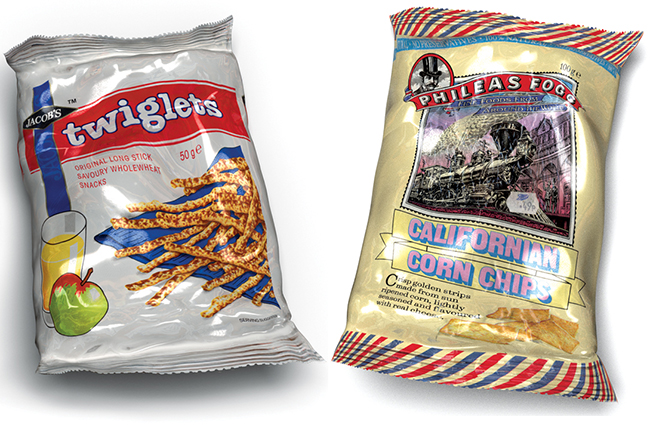
Twiglets – gathering in a small mound on the edge of a paper plate near you since 1929. A more antiquated approach from Phileas Fogg (1982).
Far from inexpensive, these snacks featured unusual ingredients, even more unusual names (Californian Corn Chips, Punjab Puri and Mignons Morceaux, to name but three), and the unlikely literary figurehead demanding we ‘Pay attention!’ on the pack. TV ads featuring top Hi-De-Hi snobs Barry and Yvonne Stuart-Hargreaves added to the elitist feel: you couldn’t just buy these snacks, you also had to buy into them.

Being light on sales but flush with product, Phileas Fogg struggled at first, but a strong showing at the International Food and Drink Exhibition in London broke the ice. Unfortunately, it also earned the attention of a few future adversaries. Smiths began secretly testing a new range of breadcrumbed pillow-shaped snacks with weird and wonderful flavourings. Though the sweet and sour pork variety failed to catch on, Scampi Flavour Fries became an instant pub sensation upon their 1985 debut. Bacon Flavour Fries (surely just Frazzles in a posh frock?) also went down a storm. Less imaginatively, KP tried to shoot down Fogg’s Montgolfier-inspired balloon by moving directly into the ‘World Snacks’ space in 1987. Their Mexican chips and garlic croutons were carbon copies of Derwent Valley’s original recipes but even new spicy poppadoms, pizza biscuits and Hong Kong crackers were packaged in the same quality gravure-printed, metallised polypropylene packs. Twiglets got in on the act too, acquiring a new heavy-duty foil bag illustrated with the constituent ingredients of a Bloody Mary, though that was soon dropped in favour of a more with-it geometric pattern to accompany the spoof ‘Dare you enter the Twiglet zone?’ ads. In a self-preservatory move, Derwent Valley branched out into cheaper snack production, adopting a one-adjective, one-shape naming policy for their crunchy sticks, pizza scoops, cheese curls and potato rackets. This helped them see out the rest of the decade before landing an exclusive deal to distribute the newly arrived Kettle Chips in the UK.
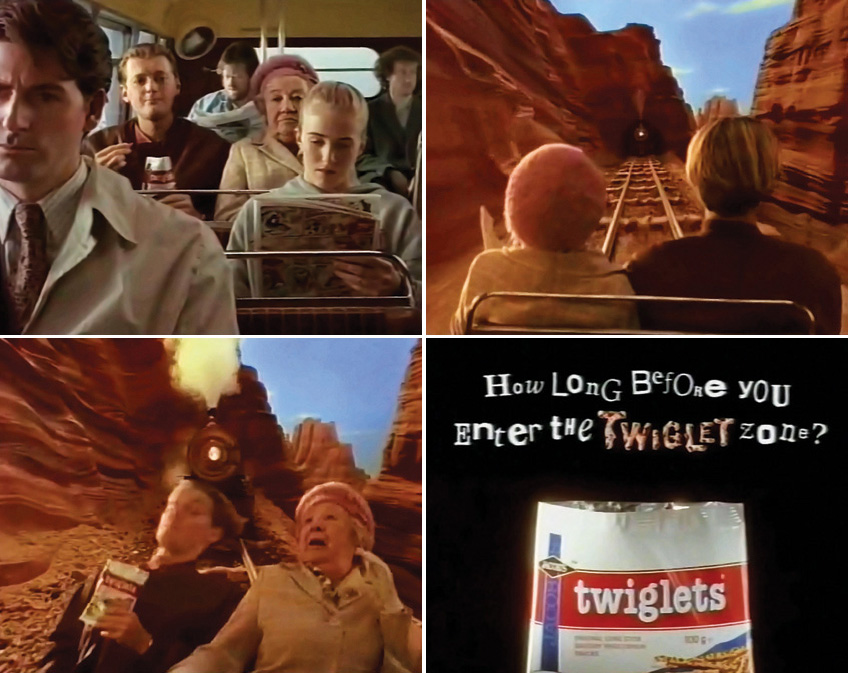
Pub favourites, like the MSG-saturated Mr Porky pork scratchings, changed hands over time and diversified. New owners Tayto introduced Porky Prime Cuts (apparently in tribute to record cutting engineer George ‘Porky’ Peckham, a man responsible for the master copies of many a vinyl pressing down the years). More processed meat in the shape of Peperami (‘People go barmy over Peperami,’ assured a young John Sessions) hung from plastic strips next to the optics and the IPA pumps. Bombay mix – wherever that came from – brought the taste of a fried curried lentil and chickpea pot pourri to the inebriated hoi polloi. No longer was the drunken wage earner limited to a strict dietary choice between a pickled egg or one of those little mint cakes at the bottom of the gents toilets.
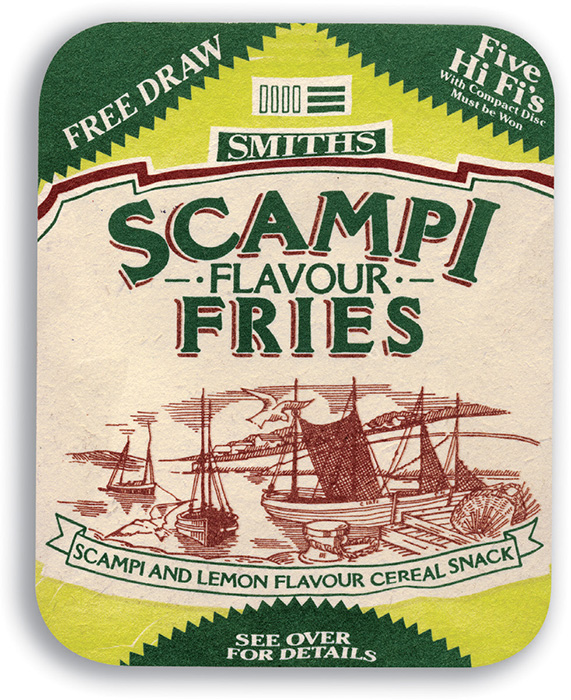
Scampi Flavour Fries – daring you to describe their aroma in family-friendly terms since 1985.
Where salt and spice succeeded, so too did soft cheese. In the midst of a new product bonanza late in 1971, Cadbury dispatched their first savoury line: Husky, a cream cheese-stuffed wafer topped with malted wheat. The Belgian TUC invasion came shortly after, with Ritz cheese sandwiches blurring the cracker/crisp boundary still further in 1983. KP’s Cheese Dip was a variation on their choc/toffee snack (developed by Meiji Seika Kaisha, United Biscuits’ trading associate in Japan), and purported that ‘dipping a stick in is gripping’. But it took the full force of the Smiths development team to come up with Savoury Moments, triangular wheat pockets with a cheesy core. Funnily enough, Michael Parkinson was less petulant when it came to accepting money to star in an advert alongside his old oppos, Rod Hull and Emu, despite the latter’s track record of assault on his goolies. Gotta credit the old bird with trying to finish the job, though.
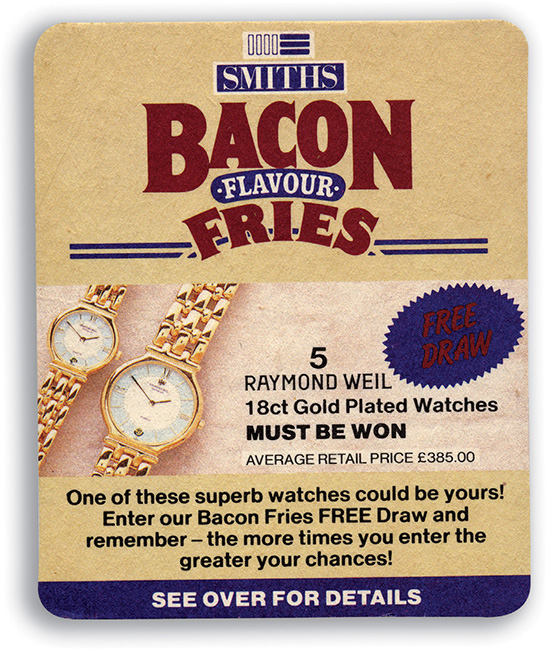
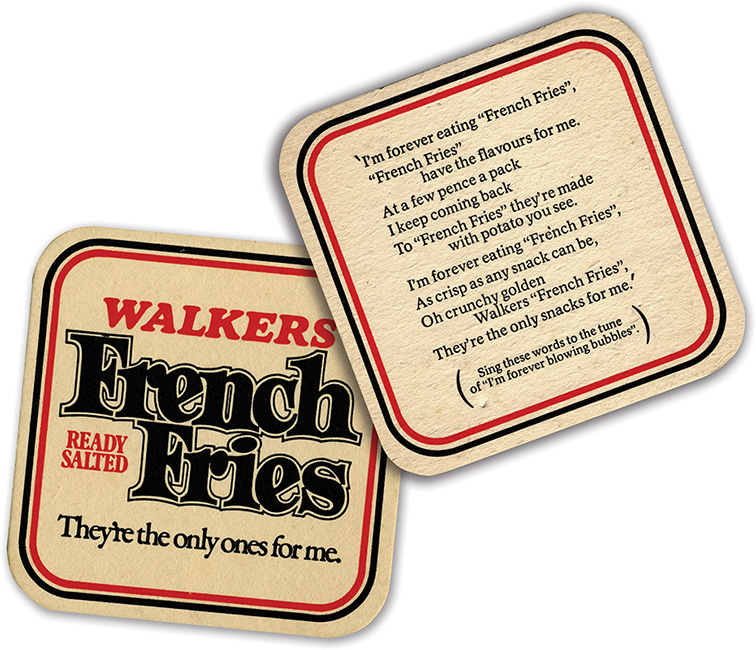
Walker’s French Fries beermats (1977), with handy tips on how to clear a crowded bar.
Typically, any product aimed at the alehouse would ultimately find its way into the lunchboxes of children. Walkers’ French Fries were conceived as a snappy little bite for seasoned tipplers, an intention reinforced by a series of pub-centric adverts and near-ubiquitous beermat promotion. However, some time in 1982 an executive took the decision to drop the ‘stacks in a pack’ strapline and instead chase the non-metric pennies with a schoolboy, his ruler, and a reminder that the bags contained ‘six and a half feet’ of fry.
Modern-day crisp-mongers like Pipers prefer their products to be exclusive to the inn (thus preventing any Tom, Dick or Harry from nipping down to Lidl and buying them at a third of the cost) and toss geographic descriptors willy-nilly at the flavours (‘Anglesey sea salt’ and ‘Somerset cider vinegar’, as if anyone cared). That’s the price you pay for a family-friendly pub. The children are all allowed indoors but, if you’re lucky, you can occasionally glimpse the old punters through the shutters – gloomy figures outside in the rain, huddled around a single cigarette, soaking wet and slovenly drunk. Still, it gets them out of the house, eh?
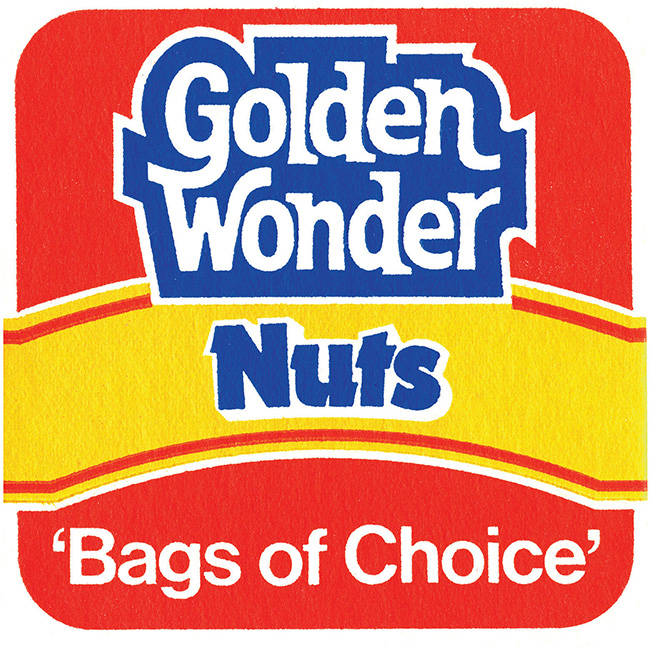
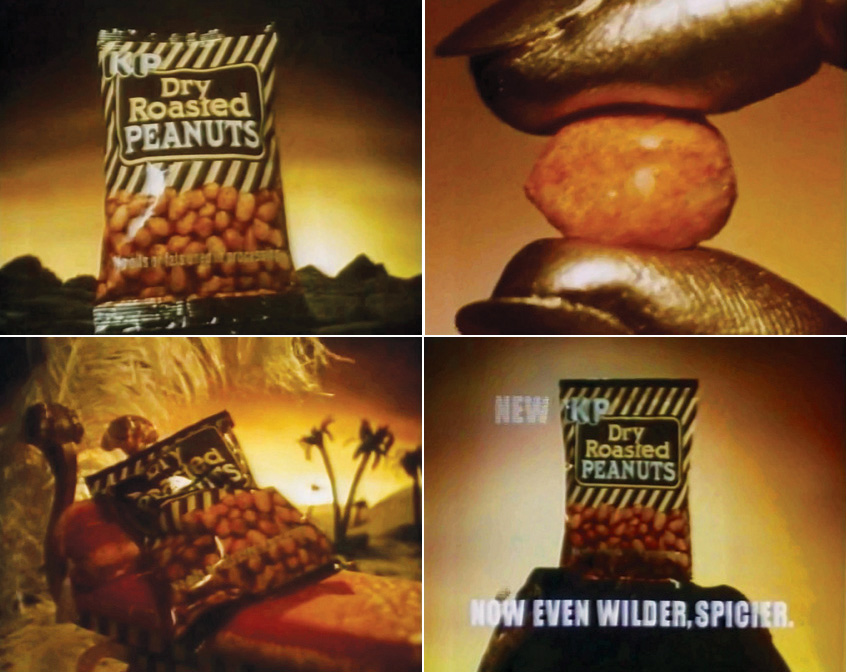
Golden Wonder’s ‘jungle fresh’ circa 1979, versus KP’s ‘jockstrap stale’ (1980).